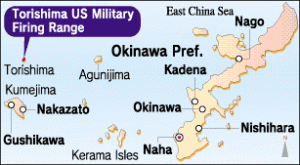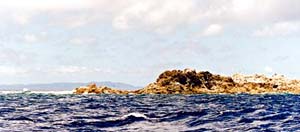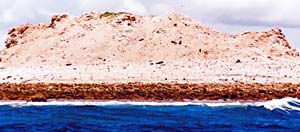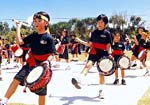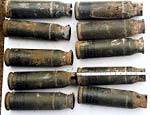Discounted Casualties:The Human Cost of Depleted Uranium, Part 6 Special Reports: DU munitions in Okinawa
Jul. 13, 2000
Growing distrust over an island of gravel
During the shell firing exercises carried out at the Torishima US Millitary Firing Range in Okinawa Prefecture in December 1995 and January 1996, the vertical take-off and landing (VTOL) Harriers owned by the US Marine Base at Iwakuni fired 1,520 rounds of DU, a radioactive weapon. This fact was revealed a little over a year later, in February 1997. The demands of Okinawa citizens that the US military retrieve the rounds were ignored. In May 2000, the US Air Force Command in Okinawa announced that they were storing DU shells in the Kadena munition storage area. A few days later, 473 rounds of used DU shell cartridges were discovered in the storehouse of a local company that purchases scrap from the US military. Thus, DU shells that should have been removed from Okinawa are still stored on the island, and negligence has resulted in the sale of used cartridges to the private sector as "steel scrap." When I visited Okinawa just prior to the G8 Summit, even as the local residents welcomed the event, their distrust of the US military was mounting. [Story and photos by Akira Tashiro]
1,520 rounds fired on the Torishima Firing Range
Only 16% of penetrators collected
Supposed to have been removed
But still in storage in OkinawaCartridges sold as "steel scrap"
Okinawa's Kumejima Island on the East China Sea is about 100 kilometers (63 miles) west of Naha City. About 25 kilometers (16 miles) north of Kumejima Island lies the Torishima Firing Range. The property is only 3.9 hectares (9.6 acres). Except for the craggy rocks on the east tip, the Ryuku limestone hillside and rocky beach on the island's south side have turned to gravel. Shells litter the slope.
Scars from a half century of exercises
On the north side are large scooped-out areas that appear to be craters created by large bombs. Bombs have scorched the east end as well. In contrast to verdant Kumejima Island visible beyond the waves, denuded Torishima, battered by bombing practice for more than half a century, looks so ravaged it seems to cry in pain.
On December 5 and 7, US Marine Harrier bombers fired 600 rounds of 25mm DU shells on Torishima Island. They fired 320 rounds of DU on January 24. Two bombers participated in the exercises on all three dates.
By the end of April 1997, the US military in Japan had retrieved 233 of the DU penetrators (weight: 148 grams), the cores from the fired shells. Only 247, or 16% of the total number of penetrators, have been retrieved so far.
Science and Technology Agency: "No effect"
The DU penetrators that struck the north slope of the island and the rocky outcropping on the east tip burned in the impact, becoming minute oxidized particles that likely dispersed in the air. They may have migrated on wintry north winds to Kumejima Island or elsewhere. Most of the retrieved penetrators were taken from the gravel on the south side, but many may still be deeply embedded in the earth.
Were all the DU rounds fired in a single flight, or over multiple flights? The answer to this question is important. The size of the island suggests that many penetrators may be submerged in the sea, as stated by the US military.
The US military in Japan claims that it has already removed contaminated soil from Torishima Island. Because a radius of three nautical miles (5.5 kilometers) around the island is off limits, the US claims that no threat whatsoever is posed to the environment or to human bodies. The Science and Technology Agency's Nuclear Safety Bureau concludes that "no DU contamination" has so far been detected in any studies of the soil, atmosphere, surrounding seawater, or fish habitat of Torishima or Kumejima islands.
Basking in the sea spray, I returned to Kumejima Island and Nakazato Village, which has administrative control over Torishima Island. The island's children struck booming taiko drums and performed the traditional dance Eisa in the square in front of Umigame (Sea Turtle) Hall to celebrate its opening. In his address, Village Headman Kyuzo Takazato (64) exhorted the families in attendance to "protect the bountiful nature and culture of Kumejima Island and preserve its environment for the sake of the Sea Turtle.
After the ceremony, we moved to the village office, where Headman Takazato expressed grave concerns about DU munitions.
Abundant fisheries also sacrificed
"The US military and Japan's Science and Technology Agency try to reassure us, but we island residents can't feel easy about it. Last May 17, I and the headman of Gushikawa Village together went through the prefectural government to ask the national government and the US military to provide physical exams for the 10,000 people living on the island, and to continue recovering the penetrators. Immediately afterwards came the news that the US Air Force is storing DU shells in the Kadena Ammunition Storage Area, and that DU cartridges like those used on Torishima Island were found. They tell us to trust them, but how can we?"
Off shore from Torishima Island, the fishing is reportedly excellent for tuna, bonito, squid and other important species. Tetsuya Tanahara (48) of the Kumejima Island Fishing Cooperative (331 members) joined our conversation and told me that on weekends, when there are no exercises, quite a few leisure boats can be seen motoring out from Naha to Torishima Island. However, though it has not been declared off-limits, all cooperative members have been warned not to fish on the north side of Kumejima Island.
"When you get caught in their drills, you never know what will fall on you. For safety's sake, we have to sacrifice that area, no matter how good the fishing is." Regret lined Tanahara's sunburned face.
No response to the fears
The residents of Kumejima Island want the US military and the national government to remove exploded and unexploded DU shells from Torishima Island and return it to its former clean state. "Tourism, farming, and fishing make good use of nature's beauty and abundance. There's nothing good about a firing range, either from the industrial or the health viewpoint," insists Gushikawa Village Headman Seiroku Uchima (59), whom I met later.
For six or seven years, a scrap company in Nishihara-machi, located in the middle of Okinawa's main island, has been storing piles of DU shell (25 mm) cartridges purchased from US military. DU shells (30 mm) are still being stored in the Kadena Ammunition Storage Area. Amazed by these reports, officials of the prefectural government, which serves as liaison between the island, the national government, and the US military, are growing distrustful. They fear for the health of the residents, as do the residents themselves.
They are pressing the US military in Okinawa to investigate when and where the discovered DU cartridges were used. "How were these dangerous cartridges allowed to be sold to the private sector, where civilians would be exposed to them?" Why are DU shells still stored in Okinawa, after the Marine Corps announced that they had all been removed?"
No response is forthcoming from the US military in Okinawa nor from its headquarters in Japan.
(Originally published on July 13, 2000)

